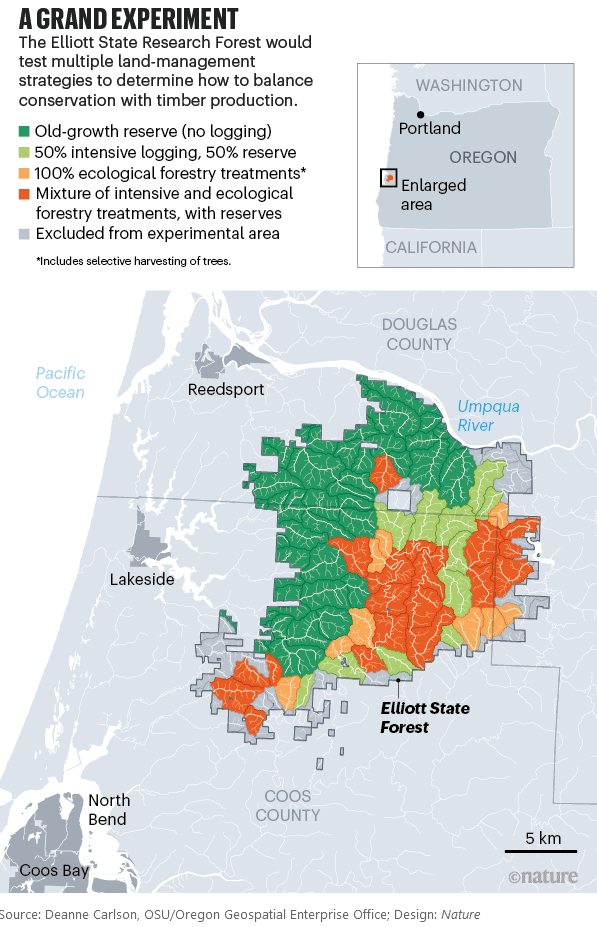Thanks to Peter Williams for this one, reported in Nature.
If the project — proposed by DeLuca and other researchers at OSU — launches successfully, the newly created Elliott State Research Forest in southwestern Oregon would occupy a roughly 33,000-hectare parcel of land. This would be divided into more than 40 sections, in which scientists would test several forest-management strategies, some including extensive logging. The advisory committee for the project, which comprises environmentalists, hunters, loggers and members of local Indigenous tribes, approved the latest research proposal on 22 April.
Controversially, the study would allow logging in a new research forest, in an attempt to answer a grand question: in a world where wood remains a necessary resource, but biodiversity is declining, what’s the best way to balance timber production with conservation?
Well, it will answer that question at least for areas similar to Elliot State Forest, anyway, or at least illuminate trade-offs. Is it controversial to allow logging in a new (or old) research forest? Most of them, at least on Forest Service land, were established to do precisely that. Here’s a link and map of all Forest Service Experimental Forests and Ranges. At least two of them, H. J. Andrews in Oregon (16K acres) and Hubbard Brook in New Hampshire are also Long Term Ecological Research units and get infusions of funding from NSF.
It’s also interesting that some environmental groups are on the advisory committee, while others think clearcutting shouldn’t occur at all, and others don’t trust OSU. The advisory committee would conceivably review plans for specific sites, though, so mistakes like the 16 acre old growth one shouldn’t occur in the future.
Questions:
“As currently designed, the project would leave more than 40% of the forest — a section of old growth that has been regenerating naturally since the area last burnt, a century and a half ago — untouched by logging.”
Is 150 years old considered “old growth” in that area? Or are there pockets of old-growth in the burned area that will be untreated?
But the Elliott research forest would be larger than most of its predecessors, and advocates say that it would provide scientists with the first opportunity to test ecological forestry at such a large scale.
I’m curious about the larger ones.. the H.J. Andrews is “only” 16,000.. I wonder where those larger ones are? I also wonder what are the kinds of specific questions for which you need more than 10,000 acres of designed experiment to answer.
Totally off the subject side note: I ran across this while looking at the (excellent) H.J. Andrews website. I found it a bit disconcerting.
CONSERVATION ETHICS
Natural resource management can be seen as a set of practices, which reflect certain ideas about the world. Ideally management practices will be consistent with our best scientific ideas about the workings of both biophysical and social systems, but management practices also and inevitably manifest our ideas about what is good, what is right, and what is valuable. For example, we manage riparian zones in certain ways because we understand certain relationships between riparian zones and streams and rivers; but also because we believe certain management practices will achieve important goals, or protect important values, related to streams and rivers. In this way, management fuses science and ethics.At the Andrews Forest, we consider ethics an inherent part of our work. We seek not only to understand how ideas work in socio-ecological systems, but also to explicitly consider how they ought to work, particularly at the interface of science and management. Formal methods of critical thinking, or argument analysis, are used to understand and evaluate both the science and ethics of management decisions, predicated on the belief that decisions made through such a process of sound and rigorous reasoning will be more systematic, more transparent, and ultimately more reasonable than they might otherwise be.
I didn’t learn much about ethics in my science education, except research ethics. I grant you that my education was a long time ago. Still, I found it pretty fascinating that the scientists are “explicitly considering how social systems (well, at least socio-ecological systems) “ought to” work. Because it sounds like “we reason more reasonably than people who make management decisions” or “we are more attuned to ethics than they are.” I’m not sure that there’s relevant social science research behind either claim.

OSU is seeking a manager for the Elliott.
https://jobs.oregonstate.edu/postings/100632
Sounds like fun! Or a can of worms.. or perhaps both.